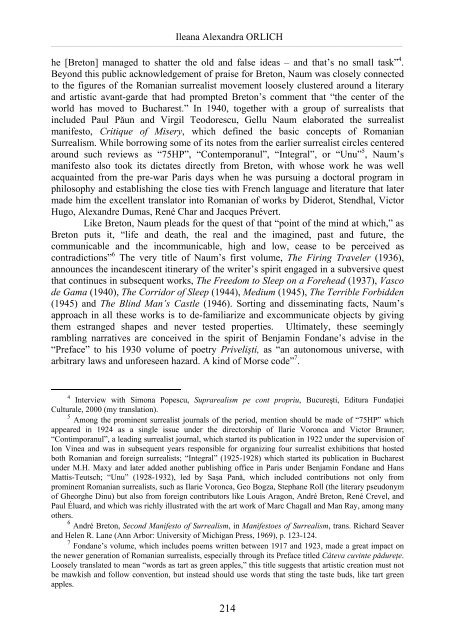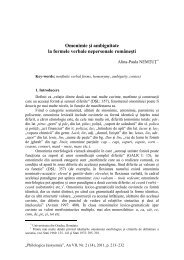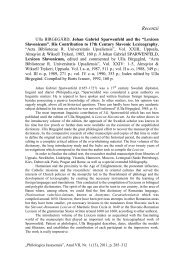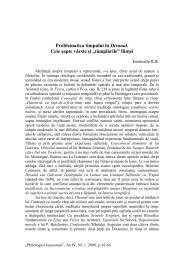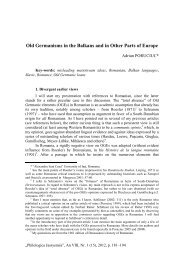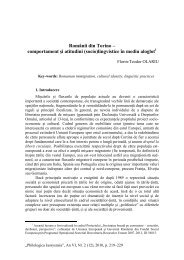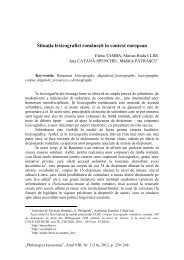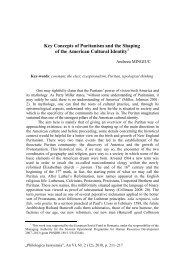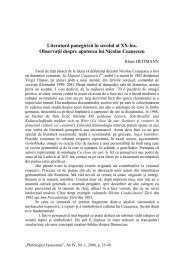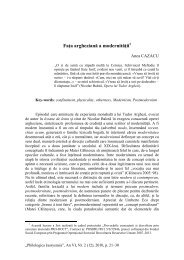Surrealism and The Feminine Element: André Breton's Nadja and ...
Surrealism and The Feminine Element: André Breton's Nadja and ...
Surrealism and The Feminine Element: André Breton's Nadja and ...
You also want an ePaper? Increase the reach of your titles
YUMPU automatically turns print PDFs into web optimized ePapers that Google loves.
Ileana Alex<strong>and</strong>ra ORLICH<br />
_______________________________________________________________________________________________________________________________________________________________________________________________<br />
he [Breton] managed to shatter the old <strong>and</strong> false ideas – <strong>and</strong> that’s no small task” 4 .<br />
Beyond this public acknowledgement of praise for Breton, Naum was closely connected<br />
to the figures of the Romanian surrealist movement loosely clustered around a literary<br />
<strong>and</strong> artistic avant-garde that had prompted Breton’s comment that “the center of the<br />
world has moved to Bucharest.” In 1940, together with a group of surrealists that<br />
included Paul Pǎun <strong>and</strong> Virgil Teodorescu, Gellu Naum elaborated the surrealist<br />
manifesto, Critique of Misery, which defined the basic concepts of Romanian<br />
<strong>Surrealism</strong>. While borrowing some of its notes from the earlier surrealist circles centered<br />
around such reviews as “75HP”, “Contemporanul”, “Integral”, or “Unu” 5 , Naum’s<br />
manifesto also took its dictates directly from Breton, with whose work he was well<br />
acquainted from the pre-war Paris days when he was pursuing a doctoral program in<br />
philosophy <strong>and</strong> establishing the close ties with French language <strong>and</strong> literature that later<br />
made him the excellent translator into Romanian of works by Diderot, Stendhal, Victor<br />
Hugo, Alex<strong>and</strong>re Dumas, René Char <strong>and</strong> Jacques Prévert.<br />
Like Breton, Naum pleads for the quest of that “point of the mind at which,” as<br />
Breton puts it, “life <strong>and</strong> death, the real <strong>and</strong> the imagined, past <strong>and</strong> future, the<br />
communicable <strong>and</strong> the incommunicable, high <strong>and</strong> low, cease to be perceived as<br />
contradictions” 6 <strong>The</strong> very title of Naum’s first volume, <strong>The</strong> Firing Traveler (1936),<br />
announces the inc<strong>and</strong>escent itinerary of the writer’s spirit engaged in a subversive quest<br />
that continues in subsequent works, <strong>The</strong> Freedom to Sleep on a Forehead (1937), Vasco<br />
de Gama (1940), <strong>The</strong> Corridor of Sleep (1944), Medium (1945), <strong>The</strong> Terrible Forbidden<br />
(1945) <strong>and</strong> <strong>The</strong> Blind Man’s Castle (1946). Sorting <strong>and</strong> disseminating facts, Naum’s<br />
approach in all these works is to de-familiarize <strong>and</strong> excommunicate objects by giving<br />
them estranged shapes <strong>and</strong> never tested properties. Ultimately, these seemingly<br />
rambling narratives are conceived in the spirit of Benjamin Fondane’s advise in the<br />
“Preface” to his 1930 volume of poetry Privelişti, as “an autonomous universe, with<br />
arbitrary laws <strong>and</strong> unforeseen hazard. A kind of Morse code” 7 .<br />
4<br />
Interview with Simona Popescu, Suprarealism pe cont propriu, Bucureşti, Editura Fundaţiei<br />
Culturale, 2000 (my translation).<br />
5<br />
Among the prominent surrealist journals of the period, mention should be made of “75HP” which<br />
appeared in 1924 as a single issue under the directorship of Ilarie Voronca <strong>and</strong> Victor Brauner;<br />
“Contimporanul”, a leading surrealist journal, which started its publication in 1922 under the supervision of<br />
Ion Vinea <strong>and</strong> was in subsequent years responsible for organizing four surrealist exhibitions that hosted<br />
both Romanian <strong>and</strong> foreign surrealists; “Integral” (1925-1928) which started its publication in Bucharest<br />
under M.H. Maxy <strong>and</strong> later added another publishing office in Paris under Benjamin Fondane <strong>and</strong> Hans<br />
Mattis-Teutsch; “Unu” (1928-1932), led by Saşa Panǎ, which included contributions not only from<br />
prominent Romanian surrealists, such as Ilarie Voronca, Geo Bogza, Stephane Roll (the literary pseudonym<br />
of Gheorghe Dinu) but also from foreign contributors like Louis Aragon, <strong>André</strong> Breton, René Crevel, <strong>and</strong><br />
Paul Éluard, <strong>and</strong> which was richly illustrated with the art work of Marc Chagall <strong>and</strong> Man Ray, among many<br />
others.<br />
6<br />
<strong>André</strong> Breton, Second Manifesto of <strong>Surrealism</strong>, in Manifestoes of <strong>Surrealism</strong>, trans. Richard Seaver<br />
<strong>and</strong> Helen R. Lane (Ann Arbor: University of Michigan Press, 1969), p. 123-124.<br />
7<br />
Fondane’s volume, which includes poems written between 1917 <strong>and</strong> 1923, made a great impact on<br />
the newer generation of Romanian surrealists, especially through its Preface titled Câteva cuvinte pǎdureţe.<br />
Loosely translated to mean “words as tart as green apples,” this title suggests that artistic creation must not<br />
be mawkish <strong>and</strong> follow convention, but instead should use words that sting the taste buds, like tart green<br />
apples.<br />
214


